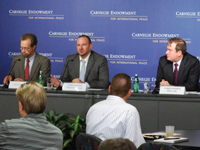Registration
You will receive an email confirming your registration.
IMGXYZ2558IMGZYXRadical cleric Anwar al-Awlaki has reportedly become the first American citizen to be placed on the C.I.A.’s list of terrorists approved for killing. Al-Awlaki's powerful appeal to violent extremists, his ties to al-Qaeda, and his apparent inspirational role in the failed Christmas Day bombing and the Fort Hood shooting have made him a high priority target for the Obama administration.
Carnegie hosted a discussion on al-Awlaki’s significance and the U.S. response to him with Christopher Heffelfinger and the New York Times' Scott Shane. Carnegie’s Christopher Boucek moderated.
Who is Anwar al-Awlaki?
According to Heffelfinger, al-Awlaki first appeared on the radar of U.S. counter-terrorism officials during the investigation of Ali al-Tamimi, a cleric from Northern Virgina who was sentenced to life in prison for inciting terrorism. While al-Awlaki had a relationship with two of the 9/11 highjackers from Northern Virginia, it is unclear what role, if any, he played in their participation in the operation. Al-Awlaki was born in New Mexico in 1971, but moved to his ancestral home of Yemen at the age of 9.
While in Yemen, he received a basic Islamic education, but nothing that would grant him clerical authority. He eventually returned to the United States and earned an engineering degree from Colorado State. Although al-Awlaki spent significant time in the United States and spoke English without at accent, Heffelfinger explained that he retained many cultural traits from Yemen, where he spent his formative years. This dual identity has played a significant role in al-Awlaki’s prominence in the Muslim-American community.
There is apparently no single specific event that led to al-Awlaki’s radicalization, according to Heffelfinger. Rather, his turn towards violent jihad was an evolutionary process. Shane noted that al-Awlaki claims that he never changed; instead, al-Awlaki says that it was the world around him that changed, citing as evidence the wars in Iraq and Afghanistan and the drone strikes in Pakistan and Yemen.
Al-Awlaki’s Rise to Prominence
After the invasion of Afghanistan, al-Awlaki began encouraging young men to go there to fight the coalition forces. However, al-Awlaki was careful to craft a public persona as a defender of the American Muslim community.
- Commentator and spokesman: In the mid-2000s, al-Awlaki emerged as a prominent and influential cleric in the United States, perhaps the most important English speaking cleric in the country. Following the 9/11 attacks, he was a frequent commentator in the American press on issues regarding Islam.
- Inspiration for jihadis: Although he has not played a strategic or operational role in terrorist attacks, his role as a source of inspiration has been critical over the past several years. Heffelfinger suggests two reasons for al-Awlaki’s prominence:
- His dual identity gives him authenticity. With his ability to speak idiomatic English and Arabic with the proper accents, he surpasses other English speaking Imams in credibility.
- His ability to manipulate his listeners by delivering messages that are both radical and unassuming. He has been referred to as the “gateway for unsuspecting.”
- American Culture: Much like Sayyid Qutb, the famous Egyptian radical, al-Awlaki’s revulsion at the decadence of American culture has compelled him to remain segregated from its society, stated Scott Shane.
- Native English speaker: “Al-Awlaki’s English skills,” noted Shane, “are misleading, in that they hide the depth of how his life was shaped during his formative years in Yemen.”
- Increasingly militant: After a stint in Yemeni prison in 2006, stemming from a tribal dispute, al-Awlaki’s began to be more militant. It is after this period that he began to become more popular and inspired several attacks, notably the Ft. Hood shooting and the failed Christmas day attack.
- The role of the media: Shane attributes al-Awlaki’s recent meteoric rise in prominence to the intense degree of media attention that he now receives. Before, he played a minor role in inspiring young radicals, but was rarely talked about in jihadi discourse online. Now, with a spate of media attention focused on him over the last year, he has become a powerful figure.
Al-Awlaki’s Future
While al-Awlaki’s popularity among the jihadist community will probably continue to grow over the years, Shane suggested that it will eventually fade and someone else will take his place. Heffelfinger suggested that the “one thing the United States could to do enhance his status is to kill him.” By declaring al-Awlaki a target for CIA assassination, the United States has put the spotlight on him and increased his status among aspirant terrorists.
Al-Awlaki is currently living in Yemen and playing some role, although most likely a non-operational one, in al-Qaeda in the Arabian Peninsula. Although the Obama administration has made clear that he is a target, the Yemenis will not extradite him to United States for two reasons.
- The Yemeni constitution forbids extradition of citizens wanted for foreign crimes.
- Doing so would likely inflame tribal tensions, presenting another challenge for the already beleaguered Yemeni state.
Al-Awlaki has become a difficult counter-terrorism case for the United States. Ultimately, defeating terrorists like al-Awlaki will require a community approach whereby members of the Islamic and international communities work together to mitigate the factors that lead to radicalization.
